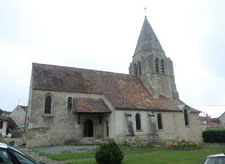Tessancourt-sur-Aubette (Yvelines, France) - Saint-Nicolas
- Disclaimer
The dating found here is based on the work of John James, and is meant on this site to serve as a starting point. James' dating is derived from a system that uses his interpretation of the development of capitals over time as the basis for chronology, among other factors. His goal is to refine the dating to within years rather than decades. I have not fully embraced James' methodology, and will be developing this page from its current state to one which is admittedly more conservative. The relative expenditure values found in the Timeline are also based on James' work, and I believe these to be reasonably reliable. They are intended only to give a sense of the amount of work involved in each decade.
I have added the idea of the "project" as a way of separating work in buildings. In my mind, a "project" is a discrete section of work in a building that resulted from the one-time acquisition of funding. "Projects" are generally separated by at least a decade where no work was being done. It is my view that it would have been unwise to start a "project" that could not be finished and protected from the elements, and as such a "project" usually involved a wing or multiple wings of a building, from floor to roof. Rural churches, which could only secure small amounts of funding at irregular intervals, often were the result of many small projects, while the great churches, which benefitted from relatively consistent funding, may have involved only a few large projects.
I have added the idea of the "project" as a way of separating work in buildings. In my mind, a "project" is a discrete section of work in a building that resulted from the one-time acquisition of funding. "Projects" are generally separated by at least a decade where no work was being done. It is my view that it would have been unwise to start a "project" that could not be finished and protected from the elements, and as such a "project" usually involved a wing or multiple wings of a building, from floor to roof. Rural churches, which could only secure small amounts of funding at irregular intervals, often were the result of many small projects, while the great churches, which benefitted from relatively consistent funding, may have involved only a few large projects.
- Timeline with Relative Expenditure (if available, in building units)
 |
 |
 |
 |
- Project A - 1070s - Phase 1 - apse
Apse with buttresses centrally on facets up to head of stairs with arch; altogether ten courses plus footings; designed for plain vaults; there was a change stone material level with window sills includes capitals of pointed framing arches and groin vaults to first bay.
- Project B - 1130s - Phase 2 - tower II
Room over vault and tower II to above the arches.
- Project C - 1150s - Phase 3 - spire
Spire by Galeran.
- Project C - 1160s - Phase 4 - n nave
North nave arcade with drum shafts and arches.
- Project D - Later - Phase 5 -
North corbels, decoration and vault.
- Primary Sources for Dating
1156/1162 - TESSANCO
Nave and tower.
Nave and tower.
… in 1156 built the first foundations of seventeen parish churches in the country near their capital city Meulun, all of the buildings were achieved in less than six or seven years with towers of cut stone and of such fine structure as those which can be seen today in the parishes of Gavancourt, Clery, Condecourt, Gaillon, Tepancourt, Hardicourt, Jambville, Livray, and several others,…
